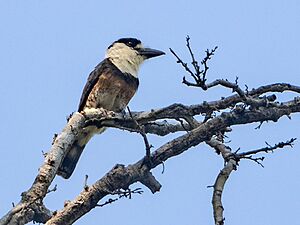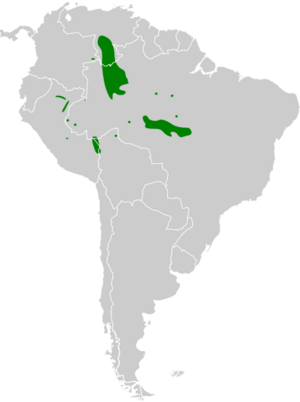Brown-banded puffbird facts for kids
Quick facts for kids Brown-banded puffbird |
|
|---|---|
 |
|
| Brown-banded puffbird at Porto Velho, Rondônia state, Brazil | |
| Conservation status | |
| Scientific classification | |
| Genus: |
Notharchus
|
| Species: |
ordii
|
 |
|
The brown-banded puffbird (Notharchus ordii) is a fascinating bird. It belongs to the Bucconidae family. This family includes other birds like puffbirds, nunlets, and nunbirds. You can find this special bird in several South American countries. These include Bolivia, Brazil, Colombia, Peru, and Venezuela.
Contents
About the Brown-banded Puffbird
Its Family Tree
The brown-banded puffbird is unique because it is "monotypic." This means it is the only species in its group. However, it is closely related to the black-breasted puffbird (N. pectoralis). Some scientists think they might even be part of a "superspecies." This means they are very similar and share a common ancestor.
What It Looks Like
The brown-banded puffbird is about 20 cm (7.9 in) long. It weighs around 51.5 g (1.8 oz). Its head, back, and a thin line near its eye are glossy black. The front of its head, face, throat, and upper chest are white. A thin white line is also at the back of its neck.
A black band separates its white upper chest from its olive-brown lower chest. The middle of its belly is white with brown spots. Its sides are white with black spots. The top of its tail is black with white tips. The underside of its tail has a white band in the middle. When it flies, you can see a white band under its wings. Its large beak and feet are black, and its eyes are dark brown.
Where It Lives
The brown-banded puffbird lives in different areas that are far apart. One large area is in southern Venezuela and northwestern Brazil. Another area is in Brazil's Rondônia state. A third spot is where Brazil, Peru, and Bolivia meet. You can also find scattered groups in other parts of Bolivia, Brazil, Colombia, and Peru.
This bird prefers to live inside and at the edges of rainforests. It also likes "transitional forests" and forests on "white-sand soils." It often stays high up in the trees, in the forest canopy.
Puffbird Behavior
What It Eats
Scientists do not know much about what the brown-banded puffbird eats. They also do not know much about its hunting style. The few times it has been seen, it hunts like other puffbirds. It waits on a perch, then quickly flies out to catch insects. It might also pick insects off plants.
How It Raises Its Young
Only one nest of the brown-banded puffbird has ever been described. It was a hole inside a tree-dwelling termitarium. This nest was about 4.5 m (15 ft) high in a mostly bare tree. Both the male and female birds helped dig out the nest.
Its Song
The brown-banded puffbird has a long song. It starts with several clear, loud whistles. Then it sings rhythmic pairs and groups of notes.
Puffbird Status
The IUCN (International Union for Conservation of Nature) has listed the brown-banded puffbird as "Least Concern." This means it is not currently at risk of disappearing. Its population size is not known, but it is thought to be stable. Even though it lives in many places, it does not seem to be very common.


